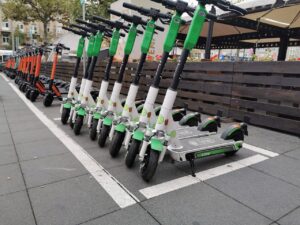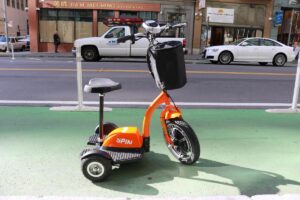Type of Service
The technology that enables electric scooter sharing evolved from bikesharing’s “smart bike” model, and it operates similarly: a smartphone app allows users to register for the service, locate and unlock/lock vehicles, and pay for rides. The scooters contain GPS and mobile telemetry units to communicate their status to the operator. Most scooters communicate a constant stream of data “breadcrumbs” that allows operators (and regulators) to monitor route, speed, maintenance needs, operating and parking location, and in some cases, incursions into geographies or parts of the right of way where they are forbidden.
Shared electric mopeds tend to borrow from (also relatively new) free-floating carsharing technology. Like their privately owned, gas-powered forebears, shared electric mopeds tend to share regulations that are beginning to be based on power output or speed. Smaller vehicles usually require a standard automobile license, as opposed to a motorcycle license, and operate in the public right of way. Although the regulations vary by state, the California DMV provides a helpful illustrated guide along with their descriptions.
Both types of shared fleets are accessed via a smartphone app. The scooters contain all of the electronics and locking mechanisms, and can be tracked by the user, operator, and if relevant, the regulating agency.
Next Subsection
Safety
Safety is a prime concern for scooter sharing systems. A study on scooter share safety conducted by the Austin Public Health Department and the Centers for Disease Control and Prevention (CDC) found that first-time users were especially likely to crash. The first of its kind, the study looks at scooter share safety by examining emergency room visits followed by telephone interviews. Just as with bikesharing, safe streets, access to helmets, and equitable enforcement of traffic laws should be examined. Seated scooters and other more stable vehicle formats might also be more accessible to users with disabilities that make stand-up scooters not feasible to use. The CDC study also found that infrastructure issues such as potholes and limited protected lanes also contributed to increased risk for accidents. These issues require a more comprehensive approach by cities to build-out micromobility infrastructure. Such investments benefit all users from those operating their own bikes to bikeshare and e-scooter programs and are important to assure a safe operating environment and to promote their use.
Some cities, such as Seattle in 2018, banned scooters altogether due to concerns about safety. However, Seattle reintroduced scooters in 2020 with updated safety rules. Some of this willingness to open doors back up to scooter companies may be due to data coming out of cities suggesting safety concerns can be managed. For example, in Portland, OR, there were 176 scooter-related emergency room visits from July 25 to November 20, 2018, which the city stipulates was fewer than the number of bicycle injuries over the same period.
Scooter companies are aware that concern regarding scooter safety is a major obstacle to greater deployment and use. In July 2019, Lime launched its Public Policy and Safety Advisory Board to help develop city-level micromobilty regulations. Another major operator, Bird, launched a 100-city tour to increase safety through virtual and in-person rider trainings.
Most cities do not require helmet-use for scooter users over 18 years, although there are free helmet distribution programs in several cities. For SFMTA’s scooter share pilot program, increasing helmet access was a safety priority for the agency, despite state law not requiring scooter riders to use them. As part of the permitting requirements, the SFMTA included a criterion for promoting and distributing helmets to riders to encourage their use. As a result, permittees distributed 1,775 free helmets to users through events or upon request. Helmet use was further monitored by the SFMTA as a safety performance indicator, and permittees were encouraged to investigate the feasibility of including a helmet with each scooter rental.
Previous Subsection Next Subsection
Data Specifications
As a new form of micromobility, scooter sharing systems often use the same data standards as bikeshare systems. The General Bikeshare Feed Specification (GBFS) is the most well-established data standard for micromobility services, and is used by more than 520 bikeshare and scooter share providers worldwide. GBFS makes real-time information available to users relating to availability of vehicles or docks. GBFS is intended to be open to the public, and thus does not include data on routes, users, or locations during trips, mainly to account for the privacy of users.
Many systems, like Oakland, CA, Chicago IL, Miami, FL, and Minneapolis, MN, use the Mobility Data Specification (MDS) for their scooter sharing systems. MDS is another data specification for use by micromobility providers, and is also intended to inform policymakers, planners, and regulators. MDS can provide information on what vehicles are in operation, battery charge, trip data, location, cost, and vehicle condition.
More information on these data specifications can be found here:
GBFS:
- MobilityData GBFS Resource Center
- NABSA: “GBFS & Open Data”
- GitHub Repository for GBFS
- GBFS Slack Channel
MDS:
- Open Mobility Foundation’s GitHub Repository for MDS
- Shared-Use Mobility Center: “Mobility Data Specification: A Data Standard for Shared Mobility Providers, Los Angeles, California, 2018”
Previous Subsection










